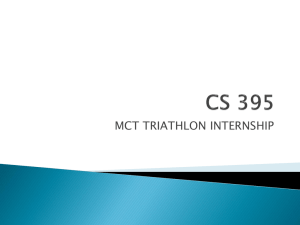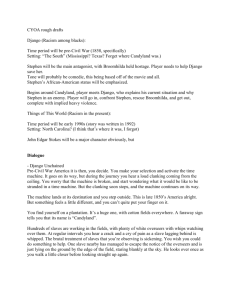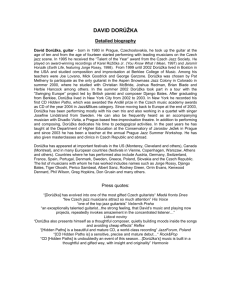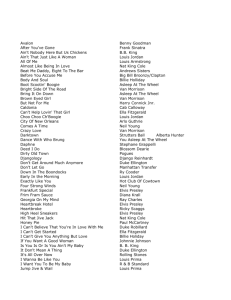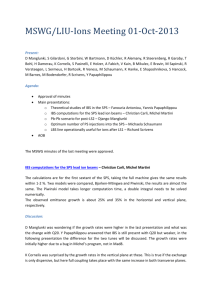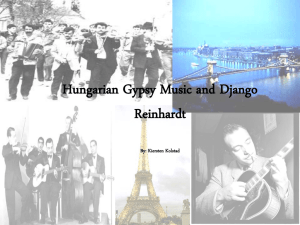Jazz and the New Orleans background (1895–1916).
advertisement
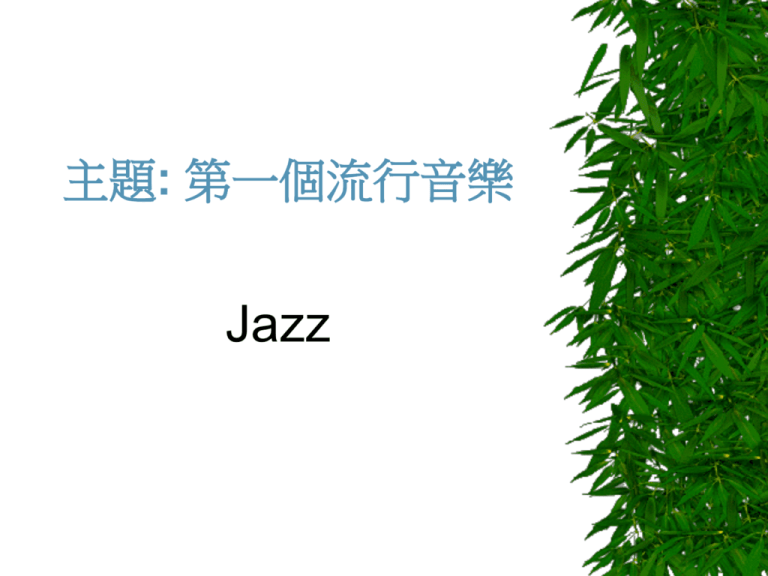
主題: 第一個流行音樂 Jazz 定義 Jazz: vt 使人更有精神更快點, n 活力精力 Jazz and the New Orleans background (1895–1916). The foundations of jazz were established by black Americans in this urban environment before the music had a name, or when it was still referred to as ragtime or ‘ratty’ music. The process unfolded as musicians gradually developed new ways of interpreting a varied repertory that included marches, dance music (two-steps, quadrilles, waltzes, polkas, schottisches and mazurkas), popular songs, traditional hymns and spirituals. Jazz and the New Orleans background (1895–1916). What might be called a nascent jazz sensibility arose from the loosening of performance strictures and the adoption of an individualistic, defiantly liberating attitude that has remained at the core of this musical tradition. Although we lack documentation that shows this process unfolding, it is possible to hypothesize some of the stages involved. Jazz and the New Orleans background (1895–1916). Rhythms, for example, gradually may have come to be interpreted more freely than in earlier 19th-century marches, ragtime and cakewalks. Phrases were stretched out and either played in a more relaxed manner or syncopated more vigorously, not just in one instrumental part but in two or more simultaneously. Jazz and the New Orleans background (1895–1916). Drummers ‘jazzed up’ – that is, enlivened – simple duple and triple metre by introducing syncopated patterns and phrasing over bar lines. Players began embellishing and ornamenting melodies, inventing countermelodies, weaving arpeggiated lines into the texture and enriching diatonic harmonies with blue notes Stephane Grappelli 1908-1997 Stephane Grappelli Stephane Grappelli born (1908) and raised in Paris was involved with music at a very early age. By 12 years, he had acquired his first violin- just one of several instruments he learned to play. He began professionally with theatre bands, eventually being introduced to jazz music. A French jazz musician, Philippe Brun, introduced Grappelli to Reindhart. Soon after that meeting they put the idea of Quintette into practice. Stephane Grappelli When World War II commenced, Grappelli and the band were touring Britain. While the others returned to Paris Grappelli decided to stay. During the next six years he became a popular figure in London with habitues of nightlife in general and in musical entertainment in particular, working with local musicians in the local clubs. In 1946, he returned to Paris, renewed association with Reindhart, but the magic of pre-war days did not re-appear too often. Stephane Grappelli During the '70s Grappelli has played throughout Europe, in Clubs, concerts and festivals, has and broadcast televised extensively, and has been a regular visitor to the recording studio. Stephane Grappelli In 1966, Grappelli was recorded in concert in Switzerland, together with fellow jazz violinist Jean-Luc Ponty, Stuff Smith and Svend Asmussen (Violin Summit). Since then he has recorded frequently in London. A live date at the Queen Elizabeth Hall (Stephane Grappelli 1972) finds him responding to an enthusiastic audience. Elsewhere he has recorded with much success, with Americans Gary Burton (Paris Encounter), Bill Coleman (Stephane Grappelli-Bill Coleman), Roland Hanna, (Stephane Grappelli Meets he Rhythm Section) and Barney Kessel (I Remember Django). Django Reinhardt 1910-1953 Django Reinhardt January 24th, 1910 at Liberchies Belgium, Django was born into the open air, rambling lifestyle of his gypsy parents. At the age of eight, his mother's tribe settled near the belt of fortifications that surrounded the old Paris, near the Choisy gate. He never wore a suit or lived in a real house until he was twenty years old. These French Gypsies or Manouches were a world unto themselves, medieval in their beliefs, and distrustful of modern science. Django grew up in this world of contradictions, one foot in the bustling big city of Paris and the other in the age- Django Reinhardt Though born into poverty Django had the soul of a nobleman and this natural elegance of bearing and attitude expressed itself in his music. It was at an early age Django became attracted to music. When twelve years old he received his first instrument, a banjo/guitar that was given to him by a neighbor who had noticed his keen interest in music. Django Reinhardt He was soon astounding adults with his ability on the guitar, and before he was thirteen he began his musical career playing with popular accordionist Guerino at a dance hall on the Rue Monge. He went on to play with numerous other bands and musicians and made his first recordings with accordionist Jean Vaissade for the Ideal Company. Since Django could not read or write at the time "Jiango Renard" was how his name appeared on these records. Django Reinhardt 1928, Django returned from a night of playing music at a new club "La Java" to the caravan that was now the home of himself and his new wife. The caravan was filled with celluloid flowers his wife had made to sell at the market on the following day. Django upon hearing what he thought was a mouse among the flowers bent down with a candle to look. The wick from the candle fell into the highly flammable celluloid flowers and the caravan was almost instantly transformed into a raging inferno. His left hand, and his right side from knee to waist were badly burned. Django Reinhardt Django was bedridden for eighteen months. During this time he was given a guitar, and with great determination Django created a new system built around the two fingers on his left hand that had full mobility. His fourth and fifth digits of the left hand were permanently curled towards the palm due to the fire. He could use them on the first two strings of the guitar for chords and octaves but complete extension of these fingers was impossible. His soloing was all done with the index and middle fingers! His technique to be graceful and precise, almost defying belief. Django Reinhardt Django was influenced by jazz recordings of Eddie Lang and Joe Venuti, Louis Armstrong and Duke Ellington. This new music found a place deep in Django's heart. It provided the perfect vehicle for his prodigious talent for improvisation. Django rarely if ever played a solo the same way twice. Numerous recordings prove this to be true. His creative genius was not only that of the master improviser, but also that of the composer, and he can be credited with numerous pieces with beautiful melodies and sophisticated, subtle harmonic structures. Django Reinhardt 1934, the most important year of his life. The Quintet of the Hot Club of France was born! As the fates would have it, the Quintet was formed by a chance meeting of Django and Stephane Grappelli. A band of fourteen musicians including Django, Stephane, Roger Chaput, and Louis Vola were commissioned to play at the Hotel Cambridge at teatime. One day Stephane joined in and both were so pleased with the exchange they went on to play together joined by Roger Chaput (guitar), Louis Vola (bass), and eventually Django's brother Joseph (guitar). Django Reinhardt A small record company Ultraphone recorded their first sides Dinah, Tiger Rag, Oh Lady be Good, and I Saw Stars. These first records caused a sensation! The Quintet went on to record hundreds of sides and had a following on both sides of the ocean. Django Reinhardt 1939 found the Quintet touring in England when the war broke out. Django returned to Paris while Stephane remained in England. Django played and recorded throughout the war years substituting Hubert Rostaing's clarinet for Stephen's violin. He somehow avoided the fate of many of his kinfolk who went to their deaths in the Nazi concentration camps. After the war he was rejoined by Stephane and they again played and recorded. He toured briefly with Duke Ellington in America and returned to Paris where he continued his career until 1951 when he Django Reinhardt In May 16th 1953 Django suffered a massive brain hemorrhage and died, leaving behind his wife Sophie and son Babik. His music remains as vital and exciting today as it was when he lived, a legacy of joy to all future generations that rediscover the genius of the Belgian gypsy Django Reinhardt. Hot club of France Louis Armstrong
